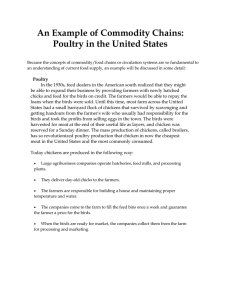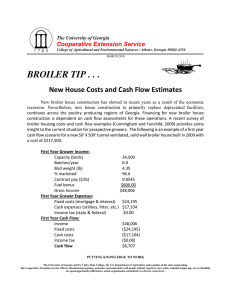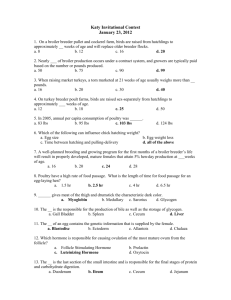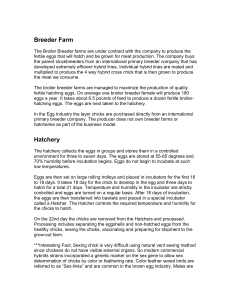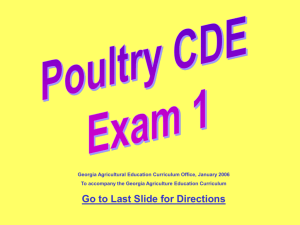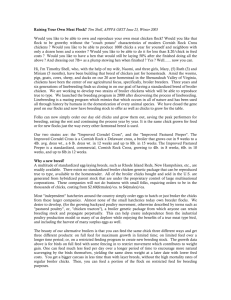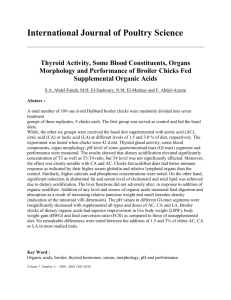Document 13161521
advertisement
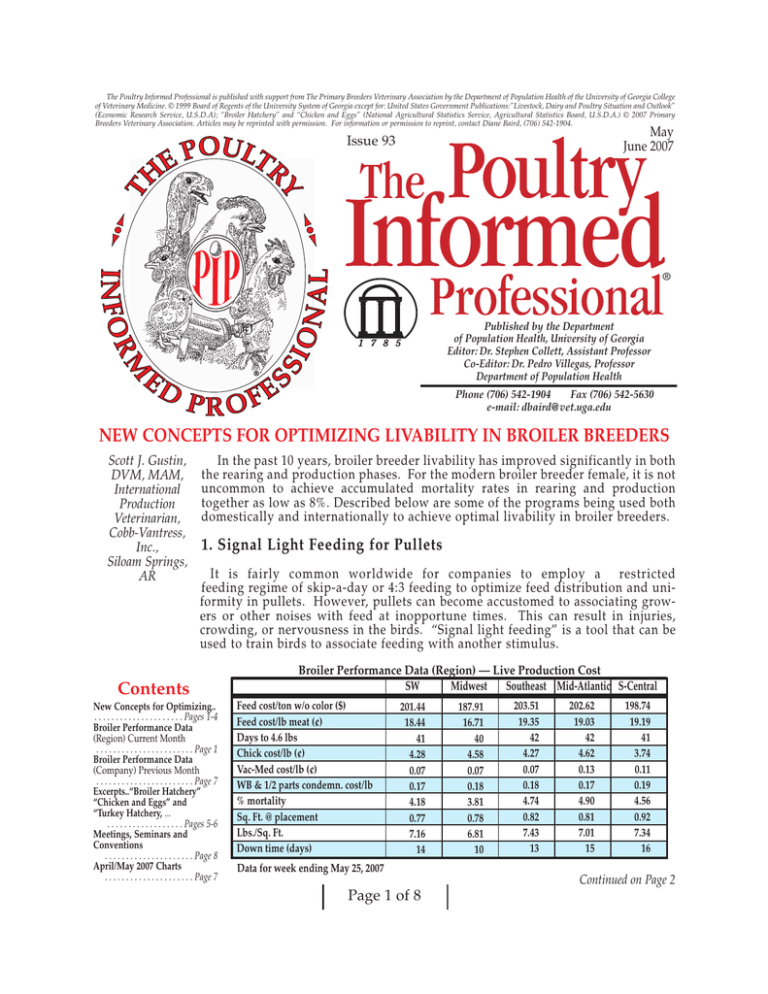
The Poultry Informed Professional is published with support from The Primary Breeders Veterinary Association by the Department of Population Health of the University of Georgia College of Veterinary Medicine. © 1999 Board of Regents of the University System of Georgia except for: United States Government Publications:”Livestock, Dairy and Poultry Situation and Outlook” (Economic Research Service, U.S.D.A); “Broiler Hatchery” and “Chicken and Eggs” (National Agricultural Statistics Service, Agricultural Statistics Board, U.S.D.A.) © 2007 Primary Breeders Veterinary Association. Articles may be reprinted with permission. For information or permission to reprint, contact Diane Baird, (706) 542-1904. May June 2007 Issue 93 ® Published by the Department of Population Health, University of Georgia Editor: Dr. Stephen Collett, Assistant Professor Co-Editor: Dr. Pedro Villegas, Professor Department of Population Health Phone (706) 542-1904 Fax (706) 542-5630 e-mail: dbaird@vet.uga.edu NEW CONCEPTS FOR OPTIMIZING LIVABILITY IN BROILER BREEDERS Scott J. Gustin, DVM, MAM, International Production Veterinarian, Cobb-Vantress, Inc., Siloam Springs, AR In the past 10 years, broiler breeder livability has improved significantly in both the rearing and production phases. For the modern broiler breeder female, it is not uncommon to achieve accumulated mortality rates in rearing and production together as low as 8%. Described below are some of the programs being used both domestically and internationally to achieve optimal livability in broiler breeders. 1. Signal Light Feeding for Pullets It is fairly common worldwide for companies to employ a restricted feeding regime of skip-a-day or 4:3 feeding to optimize feed distribution and uniformity in pullets. However, pullets can become accustomed to associating growers or other noises with feed at inopportune times. This can result in injuries, crowding, or nervousness in the birds. “Signal light feeding” is a tool that can be used to train birds to associate feeding with another stimulus. Contents New Concepts for Optimizing.. . . . . . . . . . . . . . . . . . . . . . Pages 1-4 Broiler Performance Data (Region) Current Month . . . . . . . . . . . . . . . . . . . . . . . Page 1 Broiler Performance Data (Company) Previous Month . . . . . . . . . . . . . . . . . . . . . . . Page 7 Excerpts..“Broiler Hatchery” “Chicken and Eggs” and “Turkey Hatchery, ... . . . . . . . . . . . . . . . . . . Pages 5-6 Meetings, Seminars and Conventions . . . . . . . . . . . . . . . . . . . . . Page 8 April/May 2007 Charts . . . . . . . . . . . . . . . . . . . . . Page 7 Broiler Performance Data (Region) — Live Production Cost SW Midwest Southeast Mid-Atlantic S-Central Feed cost/ton w/o color ($) Feed cost/lb meat (¢) Days to 4.6 lbs Chick cost/lb (¢) Vac-Med cost/lb (¢) WB & 1/2 parts condemn. cost/lb % mortality Sq. Ft. @ placement Lbs./Sq. Ft. Down time (days) 201.44 18.44 41 4.28 0.07 0.17 4.18 0.77 7.16 14 Data for week ending May 25, 2007 Page 1 of 8 187.91 16.71 40 4.58 0.07 0.18 3.81 0.78 6.81 10 203.51 19.35 42 4.27 0.07 0.18 4.74 0.82 7.43 13 202.62 19.03 42 4.62 0.13 0.17 4.90 0.81 7.01 15 198.74 19.19 41 3.74 0.11 0.19 4.56 0.92 7.34 16 Continued on Page 2 The premise of this concept is based upon the behaviorist Pavlov’s concept of “conditioned response.” The signal light is the stimulus that the pullets will associate with feeding and lining up on the feed track to eat. The signal light is nothing more than a low wattage light bulb hung in the house on the opposite side of the feed hopper, as indicated in the diagram (Figure 1). When birds begin feed restriction at about 3 weeks, birds are trained with the signal light system in the following manner: ✓ Lights are turned “ON” for 30 minutes to allow the birds to drink. ✓ Then lights are turned “OFF” for one minute. ✓ The dim Signal Light is turned “ON” for one minute and then the feed system is started. ✓ After feed is distributed, the feed system is shut off and then the main house lights are turned “ON.” The purpose of the signal light is that birds will move towards the light and away from where feed distribution begins (i.e. feed hopper). The light is also dim enough to allow for birds to become evenly positioned to feed while not recognizing the growers presence. While this seems like a very simple process, the potential benefits are impressive: ✓ Longer feed clean-up times which improves uniformity (up to 2 CV’s) ✓ Greater pullet livability due to fewer injuries during and after feeding ✓ Fewer pounds per good pullet due to calmer bird behavior during and after feeding The concept of “Signal light feeding” is now being incorporated into numerous companies’ pullet management programs. 2. Alternative Production Programs for Breeders Feeding Most are aware that one of the most critical periods in the life of a breeder flock is from the point of light stimulation to the point of peak production. At this time we set the course for this flock of birds and heavily influence their eventual livability and egg production. Whereas broiler breeders in the past were fed more on “linear” feeding curves at the onset and up to peak production, the best results are more commonly seen with feeding curves more conservative prior to and at the initiation of production. Conservative feeding programs from light stimulation to onset of production will help with: • Female body weight control. This is especially true with unconditioned birds as they will probably not respond to light stimulation and will utilize most of the feed to increase body weight and not to develop the reproductive system. • Egg weight control. • Reduced production mortality (prolapses, sudden death syndrome, etc.). See Fig 2. • Preventing the reproductive system from over-stimulation (double yellow follicle hierarchies that lead to double yolk eggs, internal lay, erratic ovulations, etc.). Let us begin with the breeder hen just after transfer to the production facility. From light stimulation to the onset of production the birds should be fed according to body weight. By the time 5% daily total egg production is reached, daily feed allocation should be between 125 grams and 130 grams (based on a 1300 kcal/lb diet). This level of feed should produce the correct body composition to promote good production while maintaining body weight close to target levels. By beginning with 125 grams of feed per bird per day, we leave ourselves an additional 37 grams of feed (162 g – 125 g) that we can progressively distribute from 5% production until peak production feed at 60-65% production. Once the birds reach 5% total egg production feed increases should be according to hen day egg production. This key period requires small feed increases as a conservative feeding program helps to control bodyweight and mortality from conditions such as egg peritonitis and ‘Sudden Death Syndrome’ (SDS). Calculating an amount to increase for each 5% increase in egg production allows you to follow the performance of the birds closely and react to changes quickly. Increasing feed by 2 g per 5% in the early stages up to 20% daily egg production and following this with 3 g increments up to 35% daily production is usually very effective (see Figure 3). This provides control over body weight and body composition to allow all birds time to mature and come into lay. Page 2 of 8 Once the flock has reached 35% production the majority of the birds will be in lay. To support this egg production the birds require larger feed increases so it is crucial that the daily egg production is monitored closely. Therefore, from 40% production until 60% production, the increases for every 5% production will be 4 grams (see Figure 3). The principles outlined here are examples of how to design and implement a conservative feeding program to minimize hen mortality and still achieve good peak production. Results may vary depending on the uniformity and body composition of the flocks and general facility management. 3. Slats in Pullet and Breeder Houses Many opportunities exist before and after the pullet is housed into the production facility to reduce injury and gastrocnemius tendon rupture. Numerous broiler breeder complexes have made the effort to update housing to provide for lower slat heights and accommodate the changing weight distribution of the modern broiler breeder. Ideally, slat height should reach no higher that 45 cm (~18 in.). However, companies achieving some of the best mortality figures often have a floor to slat height difference of less than 20 cm (~8 in.) In travels outside the US, it is not uncommon to have “brood, grow, lay” facilities in which the bird is never moved from rearing to production houses. Often, the nests will be placed in the rearing house as the birds mature to “train” and “acquaint” the birds with the nests prior to production. Although this “training” seems like a whimsical notion, these facilities often have very low incidence of tendon injury and rupture. Along those same lines, recent research at the University of Georgia has demonstrated that there are biochemical alterations in tendon composition due to exercise. Specifically, that exercise results in greater proteoglycan content and potential formation of stronger Type 1 collagen (Yoon, Halper, et. al.). In practical terms, the more we can encourage the developing pullet to engage muscles that will be used to leap up and down from slats before the hen is mature, the more likely we are to develop a stronger tendon that will hold up in the hen house. One management tool that has been used to emulate this process is by placing slat steps or “training slats” in the rearing house (Fig. 4). The potential exists for considerable morbidity and mortality reduction due to tendon rupture and other movement injury through this simple equipment installation. 4. Cholera Vaccination—a “Necessary” Evil? As a student I recall Dr. Glisson’s sage advice on the disease Fowl Cholera, terming it “An American Disease… like McDonalds.” As you travel to broiler breeder operations outside the United States, you will come to realize that he couldn’t be more right. Fowl Cholera has been accepted as an endemic disease of broiler breeders in the US; therefore all broiler breeders in the US must be vaccinated for Fowl Cholera, correct? More so than any other live vaccine given to broiler breeders, Fowl Cholera vaccinations come at a cost to the breeder pullet. To the broiler breeder male, the vaccination comes at even a larger cost even under ideal circumstances as they can result in chronic Fowl Cholera. In some cases, the direct and indirect costs of Fowl Cholera vaccination over a year may outweigh the associated costs of a case or two of clinical Fowl Cholera. One can make the argument that primary breeders must develop selection practices that will allow for fewer adverse reactions to live Fowl Cholera vaccines in their male and female lines. But in an age where improving Salmonella control and heightening biosecurity are the norm, aren’t we are already addressing many of the true means (rodent control, sanitation) by which Fowl Cholera is prevented? Undoubtedly, there may always be a need for Fowl Cholera vaccination in certain areas or farms. But if maximizing the production potential of broiler breeders is the objective, the dogma of Fowl Cholera vaccination as “a necessary evil”-- is oneworth challenging. Special thanks to Leasea Butler (CVI) and Philippe Gouault (Cobb-Europe) for their contributions to this article. Page 3 of 8 Figure 1. Diagram of the chicken house showing the signal light on the opposite side of the feed hopper. Figure 2. Weekly mortality trends of two groups of 12 flocks from a European company with different feeding programs after light stimulation. The aggressive feeding program created extra mortality coming into production with apparently some lingering effects for the rest of the flock’s life. Figure 3: Suggested Feed Increases Fig 4. Slat steps on the Rearing Farm Page 4 of 8 Excerpts from the latest USDA National Agricultural Statistics Service (NASS) “Broiler Hatchery,” “Chicken and Eggs” and “Turkey Hatchery” Reports and Economic Research Service (ERS) “Livestock, Dairy and Poultry Situation Outlook” Broiler Eggs Set in 19 Selected States Up 1 Percent According to the latest National Agricultural Statistics Service (NASS) reports, commercial hatcheries in the 19-State weekly program set 211 million eggs in incubators during the week ending June 30, 2007. This was up 1 percent from the eggs set the corresponding week a year earlier. Average hatchability for chicks hatched during the week was 83 percent. Average hatchability is calculated by dividing chicks hatched during the week by eggs set three weeks earlier.. Broiler-Type Chicks Hatched Up 3 Percent Broiler-type chicks hatched during May 2007 totaled 837 million, up 3 percent from May 2006. Eggs in incubators totaled 681 million on June 1, 2007, up 3 percent from a year earlier. Leading breeders placed 7.75 million broiler-type pullet chicks for future domestic hatchery supply flocks during May 2007, up 3 percent from May 2006. Turkey Eggs in Incubators on June 1 Up 2 Percent from Last Year Broiler Chicks Placed Up 3 Percent Broiler growers in the 19-State weekly program placed 181 million chicks for meat production during the week ending June 30, 2007. Placements were up 3 percent from the comparable week a year earlier. Cumulative placements from December 31, 2006 through June 30, 2007 were 4.59 billion, up 1 percent from the same period a year earlier. May Egg Production Down 1 Percent U.S. egg production totaled 7.58 billion during May 2007, down 1 percent from last year. Production included 6.45 billion table eggs, and 1.14 billion hatching eggs, of which 1.07 billion were broiler-type and 68 million were egg-type. The total number of layers during May 2007 averaged 341 million, down 1 percent from last year. May egg production per 100 layers was 2,226 eggs, up 1 percent from May 2006. All layers in the U.S. on June 1, 2007 totaled 339 million, down 1 percent from last year. The 339 million layers consisted of 280 million layers producing table or market type eggs, 56.5 million layers producing broiler-type hatching eggs, and 2.82 million layers producing egg-type hatching eggs. Rate of lay per day on June 1, 2007, averaged 72.4 eggs per 100 layers, up 2 percent from June 1, 2006. Turkey eggs in incubators on June 1, 2007, in the United States totaled 32.5 million, up 2 percent from June 1, 2006. Eggs in incubators were down 1 percent from the May 1, 2007 total of 32.9 million eggs. Regional changes from the previous year were: East North Central down 3 percent, West North Central up 2 percent, North and South Atlantic up 4 percent, and South Central and West up 4 percent. Poults Hatched During May Up 5 Percent from Last Year Turkey poults hatched during May 2007, in the United States totaled 27.4 million, up 5 percent from May 2006. Poults hatched were up 4 percent from April 2007 total of 26.4 million poults. Regional changes from the previous year were: East North Central down 7 percent, West North Central up 9 percent, North and South Atlantic up 7 percent, and South Central and West up 4 percent. Net Poults Placed During May Up 6 Percent from Last Year The 27.2 million net poults placed during May 2007 in the United States were up 6 percent from the number placed during the same month a year earlier. Net placements were up 5 percent from the April 2007 total of 26.0 million. Egg-Type Chicks Hatched Down 3 Percent Egg-type chicks hatched during May 2007 totaled 38.5 million, down 3 percent from May 2006. Eggs in incubators totaled 40.0 million on June 1, 2007, up 10 percent from a year ago. Domestic placements of egg-type pullet chicks for future hatchery supply flocks by leading breeders totaled 192,000 during May 2007, down 20 percent from May 2006. Page 5 of 8 Meat Production Increases in Second Quarter According to the latest Economic Research Service (ERS) reports, Poultry: From the beginning of the second quarter, higher numbers of broiler chicks have been placed for growout compared with the same period in 2006. This reverses the trend seen over the previous two quarters. Overall meat production in second-quarter 2007 is now expected to total 8.98 billion pounds, down less than 2 percent from the same period in 2006, and meat production in the third and fourth quarters of 2007 is expected to be higher than in the same periods in 2006. Even with growth in turkey production in the first quarter of 2007 and expected growth in the second quarter, prices for whole turkeys and many turkey parts are well above year-earlier levels. Turkey prices have benefited from the strength of broiler product prices, along with generally higher prices for beef and pork April Broiler Production Rises, Prices Strong Total broiler meat production in April was 2.86 billion pounds, up 1.6 percent from April 2006. The major reason for the production increase was that April 2007 had 1 more slaughter day than the previous year. The additional slaughter day resulted in a 2.8 percent increase in the number of birds slaughtered compared with April 2006. The increase in birds slaughtered, and a slight increase in average liveweights, was partially offset by a 1.2 percent decrease in the meat yield per bird. With a higher number of chicks being placed for growout, the total number of birds slaughtered in the second quarter is expected to be close to the number for second-quarter 2006. Overall meat production in second-quarter 2007 is now expected to total 8.98 billion pounds, down less than 2 percent from the same period in 2006. The pattern over the last several quarters of a smaller number of broilers going to slaughter is expected to be reversed in the third and fourth quarters. Broiler meat production is expected to total 18.1 billion pounds in the second half of 2007, up 2.3 percent from the previous year. Average liveweight in the third and fourth quarter is expected to be up only slightly from the previous year. Over the last 5 weeks, (May 12 to June 9), the number of chicks being placed for growout each week has been close to 181 million, up 3.5 percent from the same period in 2006. Over the last several months, prices for most broiler products have strengthened because production was lower and stock levels have declined. In May, the 12-City wholesale price for whole broilers averaged 81 cents per pound, up 36 percent from the previous year and 11 cents per pound higher than at the beginning of the year. Prices for broiler parts have strengthened to an even greater extent. In May, prices for boneless/skinless breast meat in the Northeast market averaged $1.70 per pound, up 51 percent from May 2006 and 42 cents per pound more that at the beginning of the year. With broiler production expected to increase in the second half of 2007, price increases are expected to slow and then decline in 2008. The extent of the impact on prices will depend on the health of the general U.S. economy, the available supplies of competing proteins such as beef and pork, and the strength of the export market. Turkey Production Climbs in April Turkey meat production in April was 462 million pounds, up 6.3 percent from a year earlier. The increase was, as with broilers, largely the result of an additional slaughter day in 2007 compared with April 2006. Overall turkey meat production for second-quarter 2007 is expected to be 1.48 billion pounds, up 2.4 percent from the same period in 2006. Turkey meat production (on a year-overyear basis) has been expanding for the last six quarters. The number of turkeys slaughtered increased by 5.6 percent in April to 20.5 million birds, and there was a 1-percent increase in their average liveweight. Even with turkey meat production expected to be about 3 percent higher in the first half of 2007 compared with a year ago, wholesale prices for most turkey products have remained strong. May prices for whole-hen turkeys in the Eastern region were 77 cents per pound, an increase of 8 percent from May 2006. Over the first 5 months of 2007, whole hen turkey prices have ranged between 68 and 77 cents per pound, averaging 5 percent higher than in the same period in 2006. Prices have also been higher for many turkey parts. April prices for some turkey parts were only slightly higher than a year earlier, but prices of items like wings were between 70 and 80 percent higher. Turkey prices have benefited from the strength of broiler product prices, along with generally higher prices for beef and pork. With broiler meat production expected to expand in the third and fourth quarters, prices for turkey parts are expected to gradually move closer to their yearearlier levels. Egg Production Lower in April, Production Estimates Reduced Over the first 4 months of 2007, the number of birds in the U.S. table-egg flock has averaged 287 million, down 1.2 percent from the same period in 2006. With the lower number of birds, table egg production was down 1.2 percent in the first quarter and 2 percent in April. This lower production is expected to continue in the second quarter, and the production estimate for second-half 2007 was reduced, so that production is now expected to be nearly identical to production in second-half 2006 Lower production and strong exports over the first 4 months of 2007 have led to egg prices being considerably higher than in the previous year. Over the first 4 months of 2007, wholesale egg prices in the New York market averaged 102.5 cents per dozen, 46 percent higher than in the same period in 2006. Prices in the New York region continued to be strong in May, averaging around 93 cents per dozen. Prices are expected to average between 88 and 89 cents per dozen in second-quarter 2007 (up more than 40 percent from the previous year). Prices in second-half 2007 are expected to average lower than in the first half of 2007, but to still remain higher than those of the previous year. Page 6 of 8 Current Month Charts Broiler Whole Bird Condemnation (Company) Broiler Performance Data (Company) Live Production Cost Average Co. % Septox % Airsac % I.P. % Leukosis % Bruise % Other % Total % 1/2 parts condemnations 0.156 0.098 0.027 0.001 0.002 0.009 0.298 0.326 Average Co. Feed cost/ton w/o color ($) Feed cost/lb meat (¢) Days to 4.6 lbs Chick cost/lb (¢) Vac-Med cost/lb (¢) WB & 1/2 parts condemn. cost/lb % mortality Sq. Ft. @ placement Lbs./Sq. Ft. Down time (days) Data for week ending May 25, 2007 Broiler Whole Bird Condemnation (Region) % Septox % Airsac % I.P. % Leukosis % Bruise % Other % Total % 1/2 parts condemnations SW MidWest S. East MidS. Atlantic Central 0.158 0.048 0.005 0.001 0.001 0.012 0.225 0.244 0.038 0.007 0.000 0.001 0.004 0.294 0.126 0.095 0.069 0.000 0.003 0.008 0.031 0.111 0.201 0.007 0.000 0.002 0.010 0.332 0.156 0.085 0.034 0.003 0.003 0.008 0.290 0.311 0.483 0.310 0.205 0.401 200.87 18.79 41 4.37 0.11 0.18 4.66 0.83 7.12 14 Data for week ending May 25, 2007 Data for week ending May 25, 2007 Previous Month Charts Broiler Performance Data (Company) Live Production Cost Broiler Performance Data (Region) — Live Production Cost SW Midwest Southeast Mid-Atlantic S-Central Feed cost/ton w/o color ($) Feed cost/lb meat (¢) Days to 4.6 lbs Chick cost/lb (¢) Vac-Med cost/lb (¢) WB & 1/2 parts condemn. cost/lb % mortality Sq. Ft. @ placement Lbs./Sq. Ft. Down time (days) 198.02 18.49 41 4.61 0.22 0.44 4.61 0.87 6.53 17 198.12 19.22 40 3.42 0.06 0.20 5.01 1.05 7.26 16 186.15 16.15 41 4.87 0.09 0.20 3.32 0.74 6.47 10 196.39 18.36 41 4.33 0.20 0.13 3.13 0.78 7.59 13 Average Co. 198.28 18.92 40 3.48 0.09 0.10 2.97 0.83 8.04 11 Feed cost/ton w/o color ($) Feed cost/lb meat (¢) Days to 4.6 lbs Chick cost/lb (¢) Vac-Med cost/lb (¢) WB & 1/2 parts condemn. cost/lb % mortality Sq. Ft. @ placement Lbs./Sq. Ft. Down time (days) Data for week ending April 27, 2007 194.04 18.47 41 3.96 0.13 0.24 4.53 0.92 7.08 14 Data for week ending April 27, 2007 Broiler Whole Bird Condemnation (Region) % Septox % Airsac % I.P. % Leukosis % Bruise % Other % Total % 1/2 parts condemnations SW MidWest S. East 0.240 0.933 0.022 0.001 0.002 0.005 1.203 0.196 0.096 0.010 0.007 0.002 0.005 0.315 0.079 0.027 0.004 0.000 0.001 0.001 0.112 0.309 0.034 0.009 0.000 0.001 0.002 0.355 0.085 0.087 0.018 0.000 0.001 0.004 0.196 0.192 0.387 0.296 0.568 0.125 Data for week ending April 27, 2007 Broiler Whole Bird Condemnation (Company) MidS. Atlantic Central Average Co. % Septox % Airsac % I.P. % Leukosis % Bruise % Other % Total % 1/2 parts condemnations 0.228 0.234 0.018 0.003 0.002 0.007 0.491 0.352 Data for week ending April 27, 2007 Page 7 of 8 Meetings, Seminars and Conventions 2007 July July 23-25: Biology of Breeding Poultry, 29th Poultry Science Symposium organised by the UK Branch of the WPSA. Surgeons Hall, Edinburgh, UK. Contact: Dr. Paul Hocking, Roslin Institute, Roslin, Midlothian EH25 9PS, Scotland. Phone: +44 131 527 4251; Fax +44 131 440 0434; Email: paul.hocking@bbsrc.ac.uk; Website: www.wpsa.com 2007 August August 26-30: 16th European Symposium on Poultry Nutrition, Strasbourg, France. Contact: Groupe Francais de la WPSA, BP 5, 37380 Nouzilly, France; Fax: +33 2 47 56 11 39; Email: WPSAFrance2aol.com; Website: www.wpsa.fr 2007 September September 2-5: 18th European Symposium on the Quality of Poultry Meat and 12th European Symposium on the Quality of Eggs and Egg Products 2007, Prague Congress Centre, Czech Republic. Contact: Guarant International spol.s.t.o., Opletalova 22, 110 00 Prague 1, Czech Republic; Phone: +420 284 001 444; Fax: +420 284 001 448; Email: eggmeat2007@guarant.cz; Website: www.eggmeat2007.cz September 12-15: 15th Congress of the World Veterinary Poultry Association, Jiuhua Grand Hotel, Beijing, P.R. China. Contact: Scientific issues: Dr. Xiaoling Chen. The Poultry Health Branch of the Chinese Association of Animal Science & Veterinary Medicine (CAAV), PO Box 2449-21, Beijing 1000089, P.R. China; Phone: +86 10 6217 4126; Email: llwang@wvpc2007.org; Website: www.wvpc2007.org September 25-28: 20th Latin American Poultry Congress, FIERGS Events Centre, Porto Alegre, Brazil. Contact: Website: www.avicultura2007.com.br September 26-28: 5th European Poultry Genetic Symposium 2007, Braedstrup-Horsens, Denmark. Contact: Dr. Poul Sorensen, Email: poul.sorensen@agrsci.dk; Website: www.epgs2007.agrsci.dk 2007 October October 8-10: 2007 National Meeting on Poultry Health Processing, Clarion Resort Fountainebleau Hotel, Ocean City, Maryland. Contact: Karen Adams, Delmarva Poultry Industry, Inc., 16686 County Seat Highway, Georgetown, Delaware 19947-4881. Phone: 302-856 9037; Fax: 302-856-1845. For information about meeting rooms and food accommocations at the Clarion Resort Fontainebleau Hotel, contact Kay Windsor, Phone: 800-638-2100. 2008 January January 23-25: International Poultry Expo 2008, Georgia World Congress Center, Atlanta, Georgia. Contact: US Poultry & Egg Association, 1530 Cooledge Road, Tucker, Georgia 30084-7804. Phone: 1-770-493-9401; Fax: 1-770-493-9257; Email: expogeneralinfo@poultryegg.org. Website: www.poultryegg.org or www.ipe08.org 2008 March March 5-6: Nebraska Poultry Industries Annual Convention, New World Inn & Conference Center, Columbus, Nebraska. Contact: Nebraska Poultry Industries, Inc. University of Nebraska, A103 Animal Sciences, PO Box 830908, Lincoln, Nebraska 68583-0908; Phone: 1-402-472-2051. March 5-7: Victam Asia 2008, Bangkok, Thailand. Contact: Henk van de Bunt, Victam International B.V., P.O. Box 197, 3860 AD Nijkerk, The Netherlands, Phone: +31 33 246 4404, Fax: +31 33 246 4706, Email: expo@victam.com; Website: www.victam.com or Contact: Mr. Phusit Sasitaranondha, Thailand, Phone: +66 2 640 8013; Fax: +66 2 664 2076; Email: phusit@expolink.net 2008 June June 29-July 4: XXIII World’s Poultry Congress, Convention and Exhibition Centre, Brisbane, Australia. Contact: WPC 2008 Congress, Intermedia Convention & Event Management, PO Box 1280, Milton, Queensland 4064, Australia, Phone: +61 7 3858 5594; Fax: +61 7 3858 5510; Email: wpc2008@im.com.au; Website: www.wpc2008.com Page 8 of 8 2008 August August 17-21: 8th International Marek’s Disease Symposium, Townsville, Queensland, Australia. Contact: Dr. G. Burgess, School of Veterinary & Biomedical Sciences, James Cook University, Townsville, Queensland 4811, Australia. Phone: +61 7 4781 5472; Fax: +61 7 4781 6833; Email: graham.burgess@jcu.edu.au 2009 January January 28-30: International Poultry Expo 2009, Georgia World Congress Centre, Atlanta, Georgia. Contact: US Poultry & Egg Association, 1530 Cooledge Road, Tucker, Georgia 30084-7804. Phone: +1 770 493 9401; Fax: +1 770 493 9257; Email: expogeneralinfo@poultryegg.org. Website: www.poultryegg.org 2010 April April 20-23: VIV Europe 2010, Utrecht, The Netherlands. Contact: XNU Exhibitions Europe B.V., P.O. Box 8800, 3503 RV Utrecht, The Netherlands, Fax: +31 30 295 2809; Website: www.viv.net The University of Georgia is committed to the principle of affirmative action and shall not discriminate against otherwise qualified persons on the basis of race, color, religion, national origin, sex, age, physical or mental handicap, disability, or veteran’s status in its recruitment, admissions, employment, facility and program accessibility, or services. REMINDER All previous issues of the Poultry Informed Professional are archived on our website www.avian.uga.edu under the Online Documents and The Poultry Informed Professional links.

